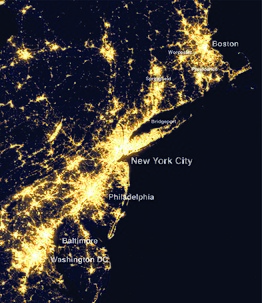
Back Megarregiones de los Estados Unidos Spanish ابرمناطق ایالات متحده Persian Megaregioni degli Stati Uniti d'America Italian ریاستہائے متحدہ دے میگا علاقے PNB ریاستہائے متحدہ کے میگا علاقے Urdu 美國大都市圈 Chinese

| Population tables of U.S. cities |
|---|
 |
| Cities |
| Urban areas |
| Populous cities and metropolitan areas |
| Metropolitan areas |
| Megaregions |
|
The megaregions of the United States are eleven regions of the United States that contain two or more roughly adjacent urban metropolitan areas that, through commonality of systems, including transportation, economies, resources, and ecologies, experience blurred boundaries between the urban centers, perceive and act as if they are a continuous urban area.[1]
Each respective region is also known as a "megalopolis", a term initially coined to define Northeastern United States, which ranges from Boston in the north to Washington, D.C. in the south. The region has an estimated population of over 50 million people as of 2022 and includes some of the nation's largest cities, including Baltimore, New York City, and Philadelphia.
© MMXXIII Rich X Search. We shall prevail. All rights reserved. Rich X Search